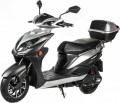Max. load
The maximum additional weight that a vehicle is designed to carry is, in fact, the weight of the payload that it is allowed to carry.
The maximum load includes both the passenger himself and the things he carries. In this case, the value is usually indicated based on a flat road and a quiet ride. So, ideally, it is best to have a maximum weight margin of at least 10-15 kg — this will give an additional guarantee in case of emergencies, such as a wheel falling into a pothole.
Max speed
The highest speed that a vehicle can reach.
When choosing according to this parameter, it is worth considering that in dense city traffic, it is rarely possible to accelerate faster than 40 km/h; so if the vehicle is bought mainly for a comfortable ride through traffic jams, then there is no need to look for a high-speed model. In addition, for the same motor power, low speed means more torque, which makes it easier to climb hills.
Wheel size
tThe diameter of the wheels used in the vehicle. For models with wheels of different sizes, the largest diameter is usually indicated, other data can be specified in the notes.
For electric scooterbikes, the traditional size is a modest 10"; larger sizes are also found — up to
16". Among minibikes, large
18" wheels are more common. Electric motorcycles have small wheels — an average of 12 – 14". Among electric tricycles, a combination of a large front wheel with small rear wheels is often found — for example, 16 "and 4" each, respectively.
The large diameter allows you to roll over the bumps on the road, overcome rather large obstacles and maintain speed longer when coasting; on the other hand, such wheels require more torque from the engine, they accelerate worse and reduce the maximum speed of the unit. Small wheels, on the contrary, accelerate well and also provide good manoeuvrability, but they are intended mainly for flat roads.
Power
The motor power of a vehicle, in horsepower.
In general, the power of electric motors is indicated in watts. However, in electric transport, this designation is also often indicated. This is done for the convenience of comparison with internal combustion engines: for internal combustion engines, especially in vehicles, horsepower is traditionally used, and it is more convenient for some users to evaluate the power of motors by this designation. At the same time, if the need arises, some units are easily converted to others: 1 hp. ≈ 735 W.
For the power value in general, see the relevant paragraph below.
Weight
The total weight of the vehicle without cargo and rider.
The
lighter the unit, the greater the range and, accordingly, the weight of the payload that can be carried on it. On the other hand, too little weight adversely affects the stability, and sometimes the overall strength of the structure.

